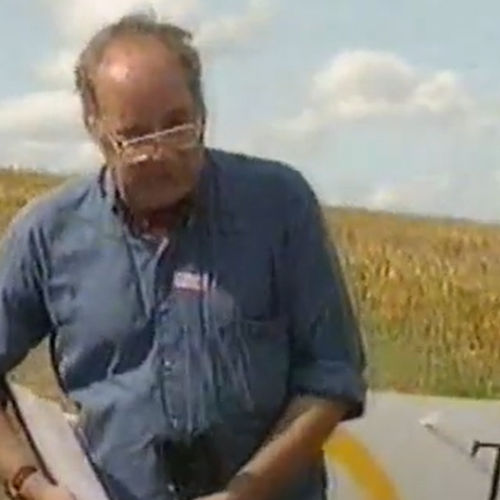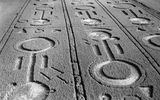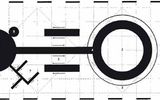
| Added | Mon, 29/05/2023 |
| Источники | |
| Феномены | |
| Версии |
Below is a translation of an interesting article "The Crop Circle Making Competition" Michellany: A John Michell Reader, (2010) pp72-76, Michellany Editions, London. by Rupert Sheldrake. She tells about the first and last official competition for drawing circles on the field, held on the night of Saturday, July 11, 1992 in a wheat field at the estate of Sir Francis Dashwood in West Wycombe (Buckinghamshire).
In 1992, John Michell and Rupert Sheldrake helped organize the first and last International Crop Circle Competition.
In the late 1970s, round patches of mysterious flattened crops appeared in the fields of the south of England, especially in Wiltshire, and throughout the 1980s they were found in increasing numbers. By 1991, the annual count was about 800. Some of them appeared in other countries, but the vast majority were and remain in England. By the end of the 1980s, some of the formations had developed far from the main circle, with concentric rings, satellite circles and rectangular, triangular and wavelike shapes.
By 1990, the most complex formations were pictograms and "insectograms". The shapes were further developed in 1991, and the season ended with an amazing fractal pattern, the Mandelbrot set, in a field near Cambridge.
In 1991, two artists in their 60s, Doug Bauer and Dave Chorley, claimed to have been drawing crop circles for years. They demonstrated their rather modest abilities to journalists. Those with a skeptical mindset tend to be gullible when it comes to the claims of hoaxers, and hastened to conclude that the hoax of Doug and Dave explained the whole phenomenon. But even if you believe their statements, they produced a maximum of 30 formations per year, leaving the vast majority unknown. Doug and Dave were puzzled themselves.
Pondering a false hypothesis to its logical conclusion has led to the treacherous territory of conspiracy theories. Who were all the hoaxers except Doug and Dave? Were they in the army or in the special services? Were they members of occult groups or secret societies? Performance artists or landscape artists?
There were also several naturalistic hypotheses: the formation of cereals was caused by complex vortices or even migrating hedgehogs. Other suggestions included psychokinetic loading from the collective unconscious or the activity of "higher intelligence" or aliens. Some people even claimed that they had tape recordings of spaceships in the fields where formations appeared at night, but ornithologists identified the high unearthly sounds as the song of a grasshopper warbler.
"Circles" usually appear at night and are fully formed by sunrise. Despite numerous attempts to observe the formation of formations, the vast majority of them appeared mysteriously. In 1991, the debate was dominated by the question of what people can and cannot do. Defenders of the mystery theories argued that various features of more complex formations, including the method of flattening crops, could not have been created by any human factor.
It was in this context that a group of people decided to organize a competition to create crop circles to find out exactly what people can and cannot do. The competition was sponsored by The Guardian and The Cerealogist, the UK's leading crop circle magazine, edited by John. The German magazine PM funded the contest, which allowed the first prize to be offered in the amount of 3,000 pounds.
The competition was announced in May 1992, and teams wishing to participate had to apply in advance. A group of crop circle experts advised the design of a standard formation that all teams had to make up. It contained elements that were supposedly difficult to deceive, such as rings, and the instructions also indicated in which directions the crop should be flattened. This design and general instructions for the participants were sent to all participants three weeks before the contest itself, so that they had time to plan their strategy. They were also sent a copy of the grading scheme, according to which the judges will distribute points according to various schemes. The venue of the competition was kept secret, and the participating teams were informed about it only 48 hours in advance.
The contest itself took place on the night of Saturday, July 11, 1992 in a wheat field at the estate of Sir Francis Dashwood in West Wycombe, Buckinghamshire, thanks to John's friendship with Sir Francis. His son Edward (now Sir Edward, the twelfth Baronet) kindly supervised the preparations, which included the installation of a tent next to the field for our organizational headquarters. On Saturday afternoon, everyone was allocated plots of the same size, which were randomly distributed among 12 competing teams. The participants had to arrive at the tent by 9 p.m., when they were given the final rules and instructions. They were free to work on their plots at night, from 22:00 to 3:00, when they had to leave the field. During this period,
Shortly after dawn, a helicopter flight was organized over the field to take aerial photographs of this place. Soon after, five referees, led by Jurgen Krenig, appeared on the field. When the organizers assembled a team of judges, they offered the Wessex skeptics, who claimed that all crop circles were a hoax, to appoint a judge, but they refused. They thought the design was too complicated to execute in the dark, and claimed that the organizers were deliberately staging an unfair competition. Doug and Dave were also invited to participate, noting that with all their practice, it should have been easy for them to win a prize of 3,000 pounds. They also refused.
However, one skeptic took part in the contest himself: Matt Ridley along with his sister. Like the Wessex skeptics, he complained that the design was too complicated and that we were loading the dice in favor of mysterious explanations. At that time, Ridley was moonlighting as a journalist at the Daily Telegraph, and also wrote books on evolutionary theory.
The contestants were very different. One team consisted of Cambridge students; The other was a group of Hampshire schoolchildren who had been training on playgrounds all week. A young American graduate student from Oxford, Jim Schnabel, worked alone. One team came in camouflage with lanterns on their foreheads. The rules stated in advance that the light can be used, but this will lead to the loss of points. All the other teams worked in the dark, including two women accompanied by a Pyrenean mountain dog who was trained to drag planks through the crops. Unfortunately, he didn't help much, because soon after the start of the contest, he fell asleep.
The night was overcast, with brief rain and only occasionally moonlight. The next morning, after the aerial photographs were taken, only the referees were allowed on the field. By noon, they had completed the assessment process, taking into account both their observations on the ground and aerial photographs. The winning team consisted of three young engineers from Westland Helicopter Company. However, before the Earl of Haddington handed them a check for 3,000 pounds, they had to build the formation again in broad daylight so that everyone could see how it was done. That morning, BBC Radio programmes about the competition revealed the venue, and a demonstration of the creation of the circle was opened to the public for a modest entry fee of £1. Several hundred people came to watch along with the TV crews.
The demonstration of the winning team was exciting. Young engineers used very simple equipment. To level the crop, they used a roller consisting of a piece of PVC pipe with a rope stretched through it, pushing it with their feet. In order to get into the crop without leaving traces, they used two light aluminum ladders with a board between them acting as a bridge. To mark the ring, a rack was not placed in the center, but a telescopic device made of plastic pipes of different diameters protruding from the top of an aluminum stepladder was used. A rope was attached to its end in such a way that by holding the rope and bypassing this central position in a circle, it was possible to distinguish a perfect ring of flattened plants, without leaving traces on the ground in the middle.
The experiment was crucial. At that time, people could really create all the features of the most modern formations. Eleven of the twelve teams built more or less impressively according to the set plan. The contest was reported in most British newspapers, on radio and television. Some were quick to conclude that all crop circles must be a hoax.
Ridley's team was the only one who didn't try to follow the set design, instead putting a question mark.
After the contest, the author of this article took part in many interviews in which he pointed out that, although the results showed that crop circles can be faked, this does not prove that they were all fakes:
"The fact that it is possible to forge a 50-pound note does not prove that all 50-pound notes are fakes."
On the same night that the competition took place, three more formations appeared on the fields in southern England. One of them was five miles from West Wycombe.
After the competition, formations continued to appear. Although their number decreased, the drawings became even more sophisticated, many of them included wonderful geometric designs. Every year, the Wiltshire Crop Circle Study Group releases a magnificent calendar that shows the best crop circles from the previous year.
Almost everyone now agrees that most crop circles are created by human hands. But some enthusiasts still believe that the minority is created by inhuman forces.
Surprisingly, an article titled "Crop circles evolve" was published about them in the scientific journal Nature on June 10, 2010. The summary reads:
"The burgeoning underground art movement combines math, technology, stems and quirks." But even this scientifically acceptable version could not dispel all the mysteries. The details of the curved stems suggest to the author of the article in Nature that "some patterns could have been created using microwave generators, such as masers or magnetrons from microwave ovens."
John loved the continued development of crop circles, their increasing geometric complexity, and the way they continue to challenge simplistic explanations.
The conclusions were made by the author of the article himself, so we will not include our own here. In fact, this article is important as information about that distant, but very important event. Note only that some modern researchers also continue to believe that the creation of such complex and geometrically correct figures is not available to humans.
Log in or register to post comments





